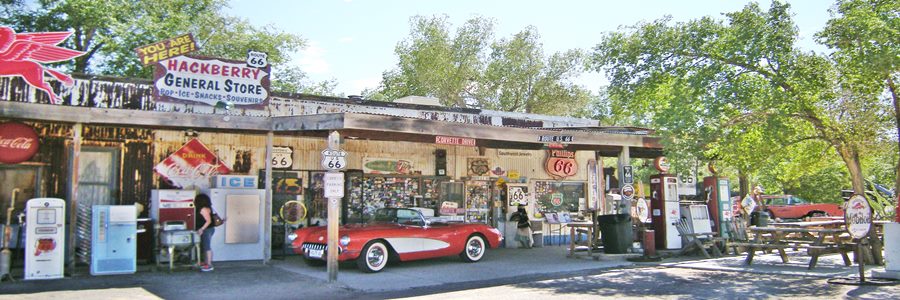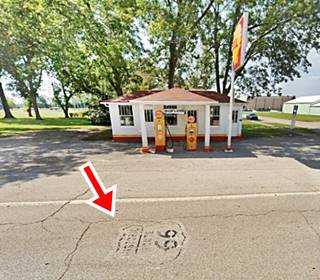The shields on Route 66
Shield on the roadway in front of a gas station between Kingman and Oatman in Arizona:
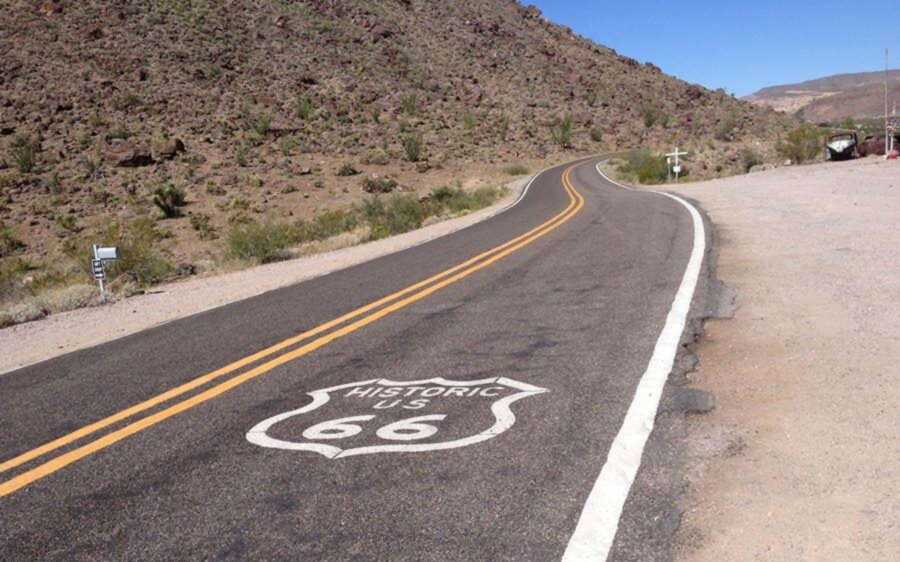
Austin Whittall
Where are the painted US 66 Shields?
State-by-State list of where the shields are located
Of course, this list is not complete, there are many more shields painted on Route 66, and we have just listed some of them. If you have any suggestions, please e-mail them to us, thanks!
Shield on the roadway in front of the gas station between Kingman and Oatman in Arizona:
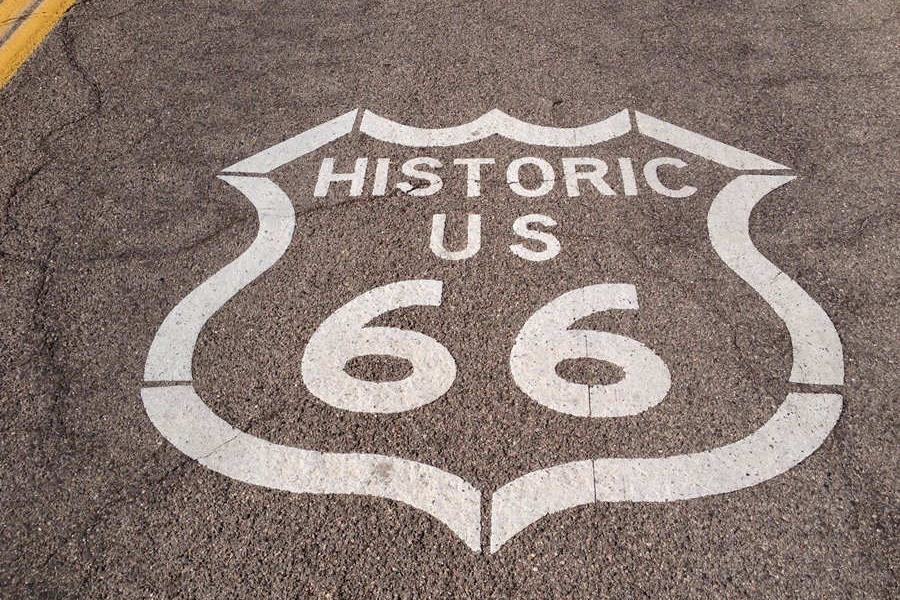
California
From West to East, these are some of the US 66 shields painted onto the road surface in California. Click the link to see it on a Google map and find it easily:
Arizona
Heading east from the Colorado River these are some shields you will see.
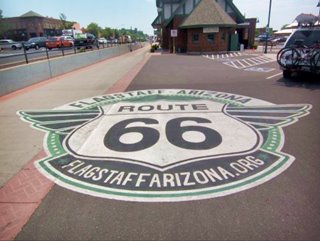
Route 66 shield by Visitor Center in Flagstaff AZ. This photo is courtesy of TripAdvisor.
- Oatman south see map.
- Oatman north see map.
- Cold Springs see map (see picture at top of page).
- Kingman south see map (pictured above).
- Kingman see map, see map 2 and see map 3.
- Williams see map.
- Flagstaff see map (pictured).
- Winslow see map (it is pictured below)
The "Standin' on a corner" shield in Winslow Arizona
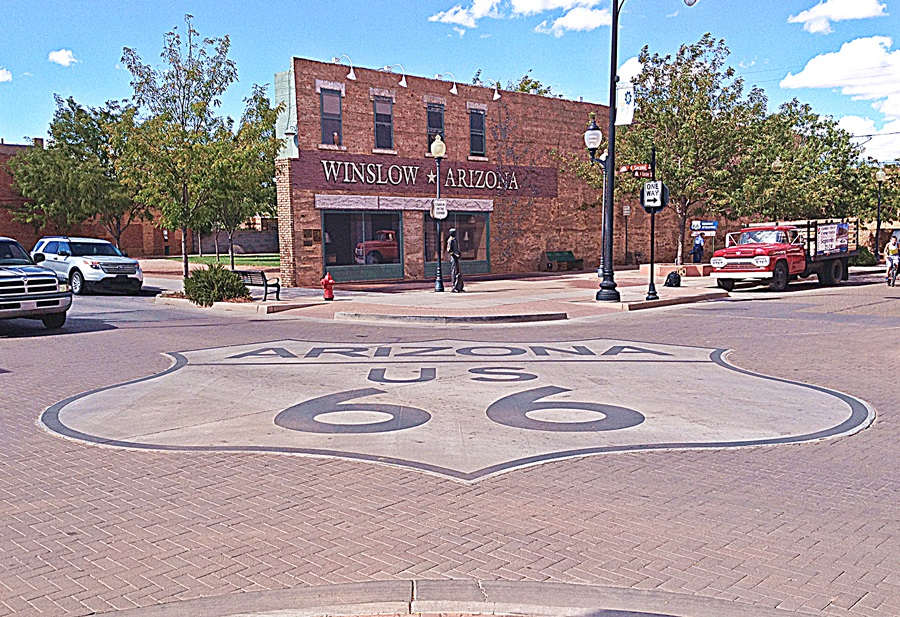
New Mexico
We list the stencilled shields from West to East
- Mesita see map, it is pictured below.
This one is just past the "Dead Man's curve" between Mesita and Laguna, New Mexico
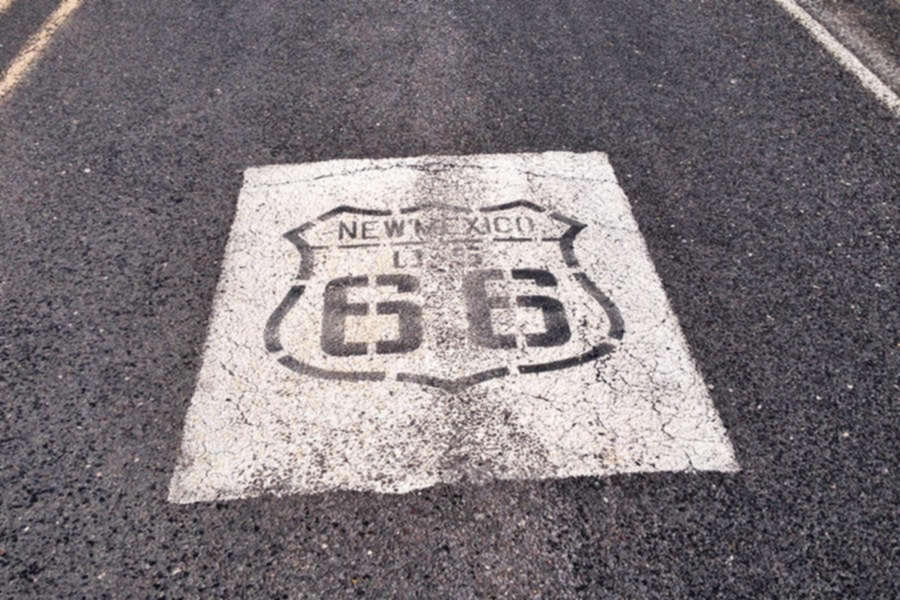
Texas
At the "Midpoint of Route 66", halfway between Los Angeles and Chicago there are some shields too!
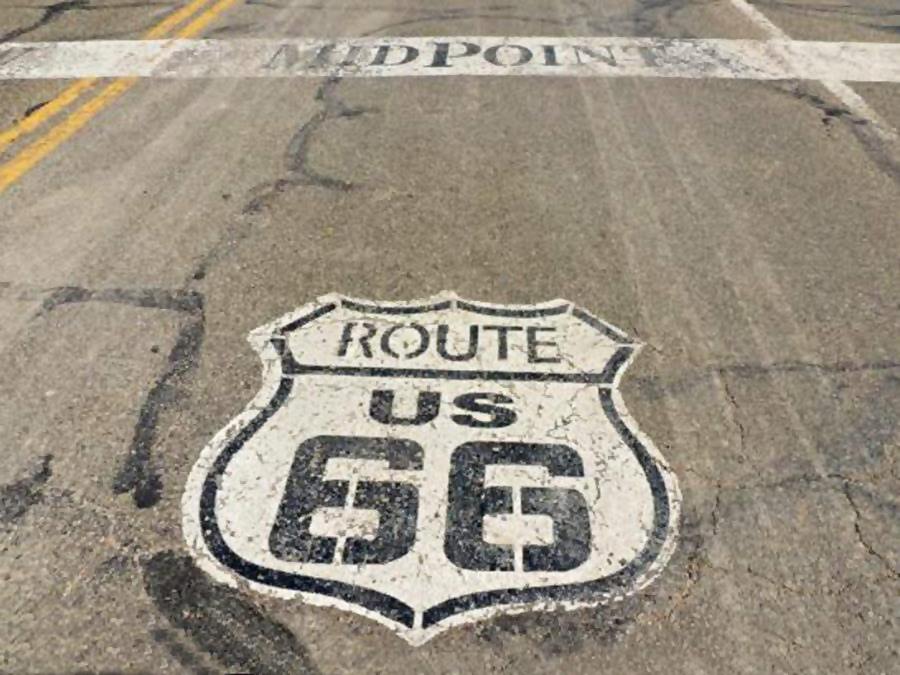

A worn U.S. 66 shield on the road surface in Commerce OK. A. Whittall.
Oklahoma
In Oklahoma, the shields that are painted on the road surface are sporadic. They tend to mark the 1930s alignment. As all shields, they are subject to the wear caused by tire abrasion and some have vanished under a new layer of asphalt when the highways are resurfaced, or they are neglected and not repainted.
We listed the painted shields from West to East (Texola to Commerce):
- Texola see map.
- Sapulpa see map.
- Tulsa West see map.
- Tulsa Eastsee map.
- Ribbon Road (Miami). See photo below.
- Commerce see map and picture.
The "Ribbon Road" in Miami, OK.

by Source

US 66 shields on the pavement at the Rainbow Arch bridge, Riverton KS. A. Whittall.
Kansas
Despite having the shortest segment of Route 66 -only 13 miles long, Kansas has quite a few shields painted on the road surface.
From Baxter Springs to Galena
Missouri

City 66 Shield painted on the paving, Marshfield MO. Credits
- Gay Parita, Paris Springs see map.
- Marshfield City 66 shields; see map.
- Lebanon see map. Pictured below.
- Devil’s Elbow see map.
- Newburg see map.
- Rolla see map. See image below.
- Cuba West see map. See picture below.
- Cuba East see map.
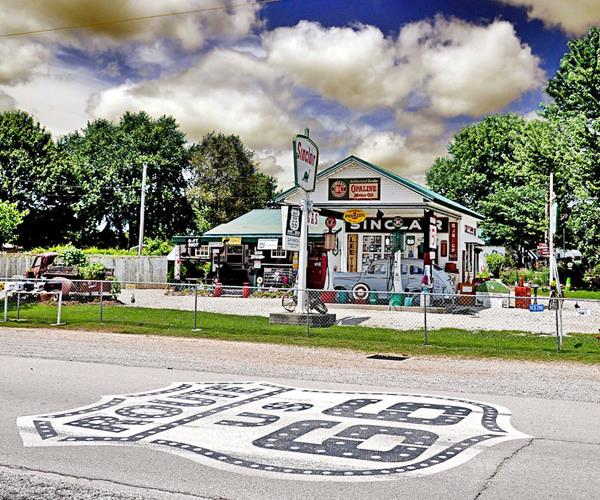

U.S. 66 Shield in Rolla MO, Source
Shield on an intersection in downtown Cuba Missouri
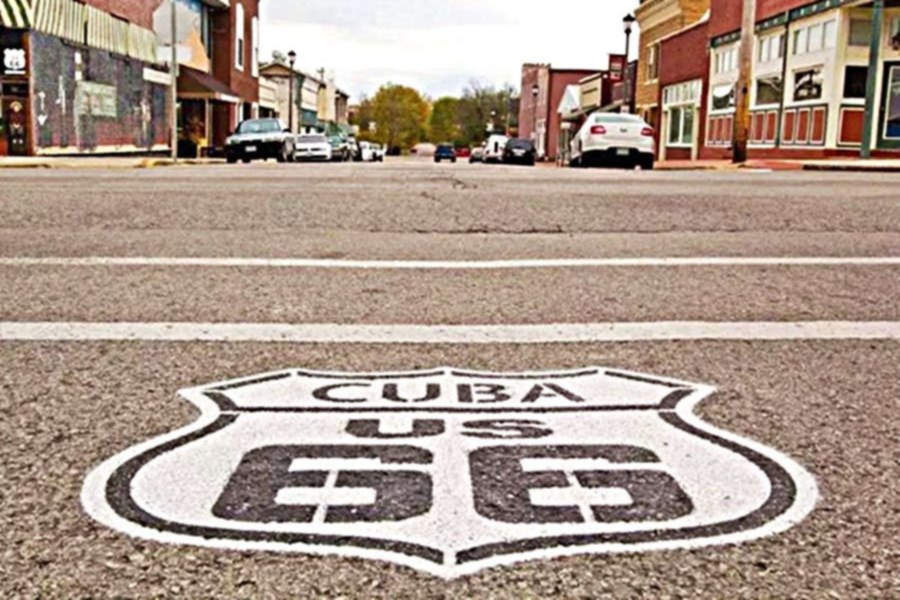
Illinois
West to East list of stencilled shields along US66 in Ilinois:
Safety and Route 66 shield selfies
Roads are dangerous places for pedestrians
Taking a selfie next to one of these stencilled Route 66 shields is becoming popular, people love to take pictures beside them.
But posing for a picture on the road is extremely dangerous. Some people even sit, squat, or lie down next to the painted shields which makes it hard to move fast to get out of the way of an oncoming vehicle.
Lying down on the pavement for a photo besid a US 66 shield painted on the pavement in Amboy California
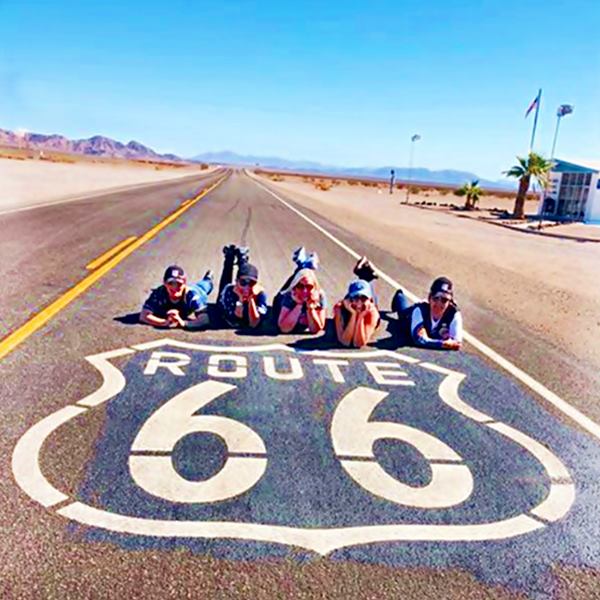
by This photo of Roy's Motel & Cafe is courtesy of TripAdvisor.
Below we share some thoughts on the dangers of taking photos of the US 66 road shields.
Safety Tips for Shield Photographers
Highways are Dangerous Places
To take your photos you will have to park your vehicle. This entails risks:
Stopping on the shoulder of a highway is very dangerous, it is in fact one of the most dangerous places to be.
Drivers tend to feel safe when parking on the shoulder of the road, they think that it is very unlikely that they will be struck by another vehicle, but this is not the case. Parking on the shoulder is extremely dangerous.
Many states have vehicle code regulations that prohibit non-emergency stops on the shoulder.
Roughly 500 people are killed each year in highway pedestrian deaths on US Interstate highways. 15% of them were on the shoulder when struck. 2
The longer you stay parked on the shoulder the higher the risk of being struck. (on average 11 minutes between stopping and being hit 1
Most deaths on the shoulder happen within 30 minutes of the driver pulling over
You would expect the shoulder (which is built to provide a safe spot to stop) to be a safe place, but it isn't: crashes do occur on the highway shoulders.
Actually 6.7% of collisions reported in a study involved cars already on the shoulder.

Parking on the shoulder is dangerous!
- Being close to a higway increases the chances of being hit by another vehicle. A high-speed impact will kill you.
- Side Swipe and rear collision: slowing down to pull off onto the shoulder is risky because the drivers in the cars following you may not pay attention to your maneouver and simply hit you from behind.
- Debris. Cars speeding along the roadway can pelter you with dust, sand and other debris.
- Re-entering roadway. After stopping you have to get back on the higway, and regain your original speed while other vehicles are approaching. This is risky too.
- Careless drivers. Those driving past you while you are parked may bbe intoxicated, blinded by the sun, or rain, they may be feeling ill, or simply distracted. These conditions could make them drive off the roadway and hit you or your vehicle. Some may even attempt to undertake anothe vehicle by driving along the shoulder.
- Mechanical problems. A car driving along the highway may experience mechanical issues and veer off the roadway to collide with you.
How to park safely for your photos
Having said this, you can also lawfully pull over to the highway's shoulder for several reasons. In fact you should not stop in a lane on the roadway (blocking the flow of traffic) but pull over onto the highway shoulder instead.
- You should exit the highway and park in a designated area beyond the highway's right of way.
- If you stop on the shoulder, make sure that your vehicle is in clear view of those driving down the roadway, for at least 300 feet in either direction.
- The highway's lane next to where you intend to stop is unobstructed and open for the passage of other vehicles along the main roadway.
- Never stop on bridges
- Don't stop close to the entrance or exit to a curve on the main highway.
- Stop as far away (to the right) from the traffic lane as possible.
- Turn on hazard lights to warn other cars that you are a potential hazard for them. It will help them see you.
- Get out of your car from the right side passenger door.
- Don't stand on the verge of the roadway, keep clear of the roadway as far away from traffic as possible.
- Don't walk between your car and the highway (on the driver's side of the car). Do so on the opposite side.
Taking your photos safely
One good thing is that there are many lonely stretches of Route 66, with little traffic, so you are "relatively" safe when you stop to snap a picture.
Plan the secuence in advance. Have someone keep an eye on oncoming traffic, from both directions (facing the photographer and behind him or her).
Avoid sitting, lying or crouching on the roadway, just stand.
Pay attention to the traffic.
Stay clear of the roadway until you take your pictures.
Do it quickly, when there is no oncoming traffic in sight.
It is safer to wait for the right moment than to risk an accident.
After the photo, get back into the car and drive off safely.
Why paint the shield on the road anyway?
Road signs come in two varieties, Vertical and Horizontal. You are familiar with both of them:
- Vertical: red stop sign, warning signs (Railroad crossing), information signs (green destination or distance ones), and Number Route Marker Signs and shields among others.
- Horizontal: longitudinal markings (lane dividers), transversal road pavement markings (Pedestrian crossing) and other markings (Bike-Only lane, RR X-ing, turn arrows, STOP and ONLY signs), etc.
To show where US Highway 66 is
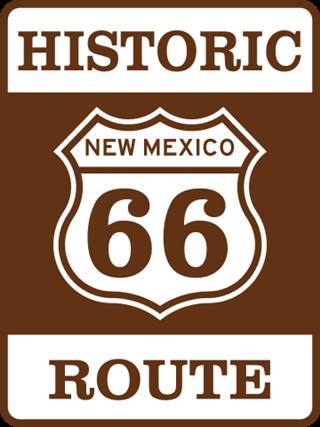
A New Mexico "Historic Route 66 Sign
Since Route 66 no longer exists as a US Highway (it was decommissioned in 1985), the classic black and white vertical US highway shields cannot be used to mark it.
This issue has been solved in part by using brown signs with white lettering to indicate the alignment of "HISTORICAL ROUTE 66".
They are more durable, visible from a distance but they are also more expensive and can get lost among the other route marker signs along the highway.
This has led to horizontal road markings to be used to indicate the alignment of former Route 66, cheaper and clear signs.
The different texts, shapes and designs of these shields
As the painted shields are the work of towns, counties or individual states, they have different designs. The images on this page show the variations in the shields and their texts.
Some only have the white words (like "Route 66" and the outline of the shield in California or "Rolla MO US 66" in Rolla or "Oklahoma US 66" on the Ribbon Road.
Others are completely painted with black words ("Cuba - US 66"for instance) on a white painted background (see Lebanon MO too) and Adrian Texas.
New Mexico and Kansas have white squares stencilled which allow the black asphalt to show through.
And others (Kingman's Visitor Center or Standin' on a Corner in Winslow) are enormous painted shields.

Workers placing shield on pavement in Tulsa OK. Source
How are the US 66 shields painted onto the pavement?
They are usually painted on to the road surface after it has been paved. The white paint usually carries reflective glass beads and its color gives it a strong contrast with the black asphalt.
It is applied manually with stencils. A stencil is a thin sheet of metal, cardboard or plastic, with gaps or patterns cut into it, that can be painted over to reproduce the pattern on the surface beneath the sheet which in this case is the asphalt or concrete roadbed.
Horizontal road markers are short lived, lasting between 9 and 36 months. This is due to abrasion of the vehicle's tires, the scraping of snow plows, and the weather (ice, sun, rain).
Road surface markings also contribute to the superficial damage of the pavement. The cause is not quite clear, but apparently water vapor trapped under the paint loosens the asphalt, breaking its bond with the gravel in the paving material. The outcome: potholes.
Another technique is to apply a thermoplastic (a polymer that softens with heat and then solidifies after it cools).
Thermoplastic markings are more durable. They are ready-made and pre-cut so their application is easy:
The road surface is swept, heated with a gas burner to remove any moisture. The pre-cut thermoplastic sign is laid on the roadway, and is bonded to the surface using the gas burner to heat it, melt it and fuse it to the asphalt of the road surface. (see the photo of Tulsa workers applying a thermoplastic road marker).
The paint used on highway road surface should be abrasive once it dries, to reduce the likelihood of vehicles skidding when the surface of the road is wet, or dry.
Some sponsored content
> > Book your Hotel in Albuquerque

Credits
Banner image: Hackberry General Store, Hackberry, Arizona by Perla Eichenblat
1 An investigation into factors associated with hard shoulder stoppages, by J Rutter - 2000, Transport Research Laboratory
2 Pedestrian Fatalities on Interstate Highways, United States, 1993-2012 (September 2014), AAA Foundation for Traffic Safety

